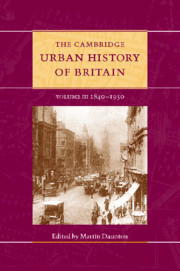Book contents
- Frontmatter
- 1 Introduction
- Part I Circulation
- Part II Governance
- Part III Construction
- Part IV Getting and spending
- Part V Images
- 24 The representation of the city in the visual arts
- 25 Epilogue
- Select bibliography
- Index
- Plates 1-7
- Plates 8-14
- Plates 15-20
- Plates 21-27
- Plates 28-34
- Plates 35-41
- Plates 42-48>
- Plates 49-53
- References
24 - The representation of the city in the visual arts
from Part V - Images
Published online by Cambridge University Press: 28 March 2008
- Frontmatter
- 1 Introduction
- Part I Circulation
- Part II Governance
- Part III Construction
- Part IV Getting and spending
- Part V Images
- 24 The representation of the city in the visual arts
- 25 Epilogue
- Select bibliography
- Index
- Plates 1-7
- Plates 8-14
- Plates 15-20
- Plates 21-27
- Plates 28-34
- Plates 35-41
- Plates 42-48>
- Plates 49-53
- References
Summary
HISTORICAL PATTERNS OF RESPONSE: CELEBRATION AND DESPAIR
Artists’ Responses to the city in the nineteenth and twentieth centuries have to be understood in terms of social and political issues and debates. The prospect of ever-increasing urban populations, particularly in the metropolis and industrial centres of the North, elicited mixed feelings in contemporary commentary. For some the growth of cities was evidence of the prosperity and strength of the national or local community. The densely packed population represented unparalleled human resources, offering skills, industriousness and simple energy to push forward the manufacturing and trading enterprises that underpinned expansion. The pace and scale of construction of transport and other infrastructural facilities, industrial and commercial premises, residential and administrative buildings and centres for worship and the arts were a source of pride and wonder to those commentators who saw the modern city in a positive light. The modern city could be celebrated as a unique source of invention and harmony, in which the collective energy and intelligence of a democracy came into play. For others pride and wonder gave way to feelings of disquiet. Awe could tip over into terror if the massed population appeared uncontrollable or the environment seemed so huge and complex that the individual was dwarfed or lost. Lack of planning and sanitation became key policy issues as the conditions of slum dwellers were investigated. The city was regularly associated with vice and its smoke and dirt were connected with immorality and crime as well as disease.
- Type
- Chapter
- Information
- The Cambridge Urban History of Britain , pp. 809 - 832Publisher: Cambridge University PressPrint publication year: 2001
References
- 2
- Cited by

